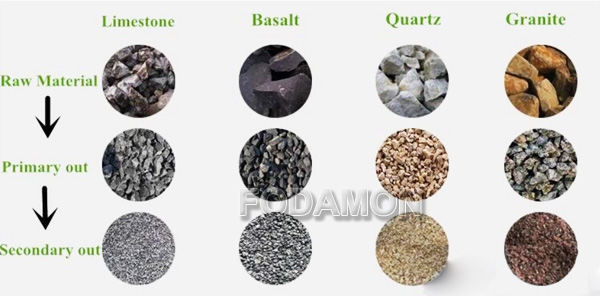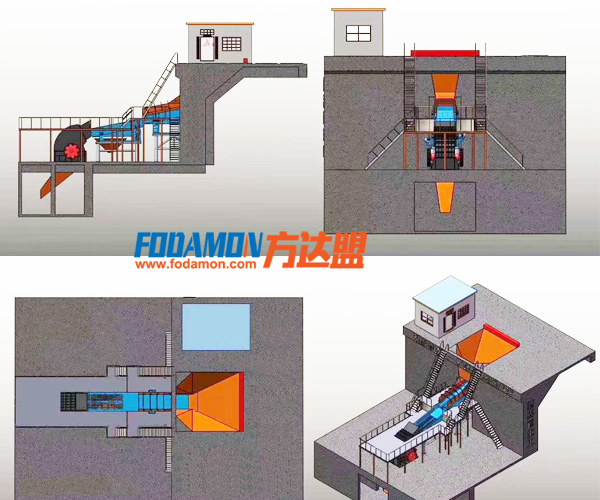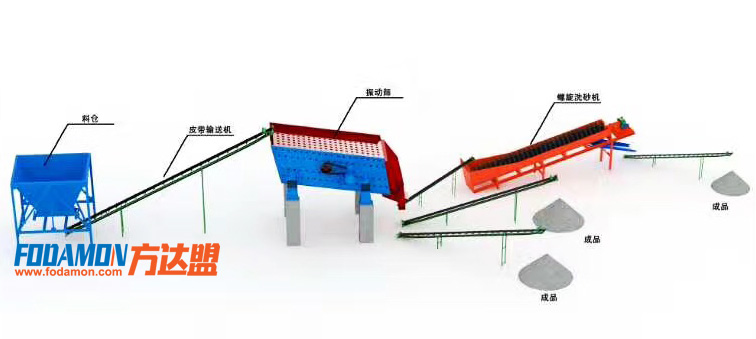Fodamon engineer has accumulated many years’experience in sand and stone crushing and sand making industry, and summarized the following knowledge about sand making for your reference.



- What kinds of rocks are there in nature?
Natural rocks are divided into three types: the first is magmatic rocks (igneous rocks), which are formed by magmatic eruption and are generally hard and homogeneous in texture; the second is sedimentary rocks (hydrogenic rocks), which are formed by a series of geological processes such as weathering, transportation, sedimentation and diagenesis, and are characterized by layered distribution. The third type is metamorphic rock, which is formed after metamorphic mixing on the basis of existing rocks and has both the above-mentioned rocks and their own characteristics. - Which rocks can be used for machine-made sand production?
The raw materials of machine-made sandstone (gravel) are usually granite, basalt, river pebble, cobble, andesite, rhyolite, diabase, diorite, sandstone and limestone. The mechanized sand made from the sand can be distinguished according to rock types, and there are also differences in strength and use. - Why should we replace grinding with crushing, more crushing and less grinding?
Because the energy utilization ratio of crushing is higher than that of grinding, more crushing and less grinding are beneficial to saving energy, but they can not be completely replaced by crushing, because the energy utilization of both materials changes inversely as the particle size of materials decreases. - What are the characteristics of impact crusher “stone beating stone” and “stone beating iron”?
“Stone beating stone” is suitable for medium hard and above abrasive materials, such as basalt. Under the working condition of “stone beating stone”, the finished product has better grain shape and slightly more powder content. “Stone beating iron” is suitable for materials with low abrasion under medium hard, such as limestone. Under the working condition of “stone beating iron”, the crushing efficiency is high, the wear cost of the perimeter plate is high, and the grain shape of the finished product is slightly worse. The most serious wear of “stone beating iron” should be anvil, so its structure design and casting technology are also important factors affecting the efficiency of sand making machine. In addition, “stone beating stone” is suitable for shaping, and “stone beating iron” is suitable for sand making. - What are the basic steps of balancing sand machine?
After changing wear-resistant parts of impeller rotor of impact sand machine, the basic steps of correcting static balance of impeller rotor are as follows:
a, Cleaning sand, stone, old wear parts and debris on the rotor and accessories, and confirming that they can continue to be used;
b, reinstalling wear-resistant parts and installing the rotor on balancing fixtures;
c, determining unbalanced weight and position;
d, Review the balance of the balanced rotor. - What are the factors affecting the efficiency of impact sand machine?
a, Characteristics of raw materials. The material has low hardness, low strength, good fragmentation and high sand making efficiency.
b, The influence of water content of crushed materials. When the water content is high, the sand production will be reduced.
c, The size of feed. Generally speaking, the larger the feeding amount, the better the crushing effect, but there are extreme points.
d, The speed of impeller. Generally, the higher the speed, the better the crushing efficiency. - The type of vibrating screen used in machine-made sand screening at present?
Screening equipment mainly used for sand production is: bar screen, cylinder screen, circular vibrating screen, linear vibration screen, high frequency screen and probability screen six types, bar screen is mainly used in soil removal process, circular vibration screen, linear vibration screen is more common. - What factors can cause screen blocking?
a, There are a lot of gravel particles with critical separation points in sand and gravel.
b, There are more flaky materials in sand and gravel, and because of rock crushing or the reasons of sand and gravel itself, there are more flaky materials in sand and gravel, so the flaky materials in screening can not be screened smoothly by themselves.
c, Mud content in sand and gravel is high.
d, The water content in sand and gravel is higher. - What are the main causes of screen breakage?
a, Screen quality or material is not up to standard;
b, The tension of the screen is not enough, which causes the screen to flutter, and usually breaks or damages along the edge of the screen or at the edge of the blanking press.
c, The vibration amplitude of the screen is too small, which results in the accumulation of sand and gravel particles on the screen and quickly damages the screen. - What is the relationship between fineness modulus and sieve size?
At present, the general requirement for fineness modulus of manufactured sand is 2.6-3.0. The sieve size is generally recommended to be 3.0 mm or 3.5 mm. If the content of stone powder is high, 2.8mm screen can be considered; if it reaches about 2.3, long screen, such as 1.7X5 or 1.9X5, can be considered. Square-hole screen is usually used as far as possible, which is very beneficial to particle shape control; round-hole screen or strip screen is used as little as possible; and it is also necessary to monitor whether the screen is damaged and affect the fineness modulus from time to time. - What are the spare parts of impact sand machine?
Standard vulnerable parts are: cylindrical roller bearing, deep groove ball bearing, thrust ball bearing, expansion sleeve, conveyor belt, oil seal, O-ring. Non-standard vulnerable parts are: upper sleeve, lower sleeve (the lifting part of feeding hopper), shock absorber rubber, roll guard ring, upper/lower runner plate, impact block, dividing cone, wear-resistant plate, throwing head, blanking lining ring, feeding pipe, upper/lower impact protective plate, hopper lining ring, dividing tray, bulk tray (bulk cone), perimeter guard plate. - Apparent density of manufactured sand, loose packing density and other requirements?
The apparent density of manufactured sand is not less than 2 500 kg/m_and the bulk density of loose sand is not less than 1 400 kg/m and the void fraction is not more than 44%.
